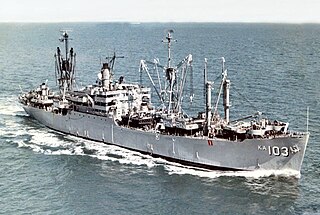
USS Shangri-La (CV/CVA/CVS-38) was one of 24 Essex-class aircraft carriers completed during or shortly after World War II for the United States Navy.

USS Wright (CVL-49/AVT-7) was a Saipan-class light aircraft carrier of the U.S. Navy, later converted to the command ship CC-2. It is the second ship named "Wright". The first Wright (AV-1) was named for Orville Wright; the second honored both Wright brothers: Orville and Wilbur.

USS Shasta (AE-6), an ammunition ship, was laid down under Maritime Commission contract on 12 August 1940 by the Tampa Shipbuilding Company, Tampa, Fla., initially as a C2 type cargo ship. She was acquired by the Navy on 16 April 1941 and launched on 9 July 1941, sponsored by Mrs. Spessard L. Holland. She was commissioned on 20 January 1942. She was named after Mount Shasta, a volcano in the Cascade Range in northern California, USA.

USS Wrangell (AE-12) was laid down under a Maritime Commission contract as SS Midnight during February 1944 at Wilmington, North Carolina, by the North Carolina Shipbuilding Company; launched on 14 April 1944; sponsored by Mrs. G. T. Cambell; delivered to the Navy, incomplete, on 28 May 1944; moved to Hampton Roads; converted to an ammunition ship by the Norfolk Shipbuilding and Drydock Co.; and commissioned on 10 October 1944 at the Norfolk Navy Yard.

USS Warrington (DD-843) was a Gearing-class destroyer that served the U.S. Navy from the end of World War II to the Vietnam War, when she was damaged by two underwater explosions, causing her to be listed as "beyond repair" and excessed to the Navy of the Republic of China.

USS English (DD-696) was an Allen M. Sumner-class destroyer. She was named for Rear Admiral Robert Henry English, a submariner who commanded the light cruiser Helena and had been awarded the Navy Cross and the Navy Distinguished Service Medal. English died in the crash of Pan Am Flight 1104 on 21 January 1943.

USS Noxubee (AOG-56) was a Patapsco-class gasoline tanker acquired by the U.S. Navy for the task of transporting gasoline to warships in the fleet, and to remote Navy stations. She served in a commissioned status from 1945 to 1959, and 1965–1975. She was named for a river in Mississippi.

USS Sylvania (AFS-2), a Mars-class combat stores ship, was the second ship of the United States Navy to be named Sylvania.

USS Warrington (DD-383) was a Somers-class destroyer, laid down on 10 October 1935 at Kearny, New Jersey, by the Federal Shipbuilding and Drydock Company; launched on 15 May 1937; sponsored by Miss Katherine Taft Chubb; and commissioned at the New York Navy Yard on 9 February 1938.

USS Rankin (AKA-103/LKA-103) was a Tolland-class attack cargo ship in service with the United States Navy from 1945 to 1947 and again from 1952 to 1971. She was finally sunk as an artificial reef in 1988.

USS Turner (DD/DDR-834) was a Gearing-class destroyer of the United States Navy, the third Navy ship named for Captain Daniel Turner (1794?–1850).

USS Aldebaran (AF-10), the lead ship of her class of stores ship is the only ship of the United States Navy to have this name. She is named after Aldebaran, a star of the first magnitude in the constellation Taurus.

USS Basilone (DD/DDE-824) was a Gearing-class destroyer of the United States Navy, named for Gunnery Sergeant John Basilone (1916–1945), who was awarded the Medal of Honor for "extraordinary heroism and conspicuous gallantry in action...." in the defense of Henderson Field during the 1942 Guadalcanal campaign.

USS Waccamaw (AO-109) was a Cimarron-class replenishment oiler in the United States Navy. She was named after Waccamaw River. The original capacity was 146,000 barrels (23,200 m3).

USS Sierra (AD-18) was a Dixie-class destroyer tender built just before the start of World War II for the U.S. Navy. Her task was to service destroyers in, or near, battle areas and to keep them fit for duty.

USS Polaris (AF-11) was a Type C2 "Liberty fleet" standard freighter and an Aldebaran-class stores ship acquired from the United States Maritime Commission by the US Navy for World War II and the Korean War. She was launched in 1939 at Sun Shipbuilding & Drydock Co., Chester, Pennsylvania.

USS Adria (AF-30) was an Adria-class stores ship in service with the United States Navy from 1944 to 1954. She was scrapped in 1977.

USS Alstede (AF-48) was an Alstede-class stores ship acquired by the U.S. Navy at the end of World War II. Her task was to carry stores, refrigerated items, and equipment to ships in the fleet, and to remote stations and staging areas.

USS Denebola (AF-56) was a Denebola-class stores ship acquired by the U.S. Navy. She was built as SS Hibbing Victory as a type VC2-S-AP2 Victory ship built by Oregon Shipbuilding Corporation of Portland, Oregon, under a Maritime Commission. The Maritime Administration cargo ship was the 113th ship built. Its keel was laid on 2 May 1944. The ship was christened on 30 June 1944. She was built at the Oregon Shipbuilding yards in just 59 days, under the Emergency Shipbuilding program for World War II. The 10,600-ton ship was constructed for the Maritime Commission. She was operated by the (Pacific-Atlantic SS Company under the United States Merchant Marine act for the War Shipping Administration. The other two ships in her class were USS Regulus and USNS Perseus. USS Denebola's task was to carry stores, refrigerated items, and equipment to ships in the fleet, and to remote stations and staging areas.

USS San Diego (AFS-6) was a Mars-class combat stores ship acquired by the U.S. Navy in 1968. She served the U.S. Atlantic Fleet until decommissioned in 1993. She then was redesignated as a United States Naval Ship, assigned to the Military Sealift Command, and served in a non-commissioned status with a mostly civilian crew as USNS San Diego (T-AFS-6) until 1997.




















